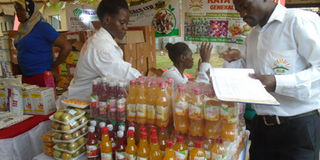Value addition: Secret to earning from gooseberry

Augustine Muworozi (right) adds value to gooseberries, making juice that he sells mainly in major towns. photo by Fred Muzaale
What you need to know:
- Gooseberries have until recently been considered wild plants.
- Augustine Muworozi a farmer in Rukiga District has transformed this berry into a goldmine.
- Muworozi started planting and adding value to the berries four years ago.
- He tells Fred Muzaale how he got the idea and grew a business out of it.
Gooseberries, known as etuntunu in Luganda is considered a wild fruit. Many people who eat them come across them accidentally in the bushes, where they grow and after picking those that are ripe, eat them fresh.
However, as more people become aware of their health benefits, their consumption has increased, resulting into some farmers to begin growing them on a commercial scale.
One such farmer is Augustine Muworozi, who grows the fruit in Kyabuhangwa parish in Kamwezi Sub-county in Rukiga District.
Under his company, Kata Orchard General Suppliers Ltd, Muworozi currently owns five acres of the fruit from which he extracts gooseberry juice.
He also sells packed fresh berries and in future, he plans to start making gooseberry wine. The fruit is organically grown.
Muworozi makes his juice at Uganda Industrial Research Institute (UIRI) in Nakawa.
A holder of a certificate in catering and hotel management says he began making gooseberry juice in 2018, after receiving training from UIRI.
How to make juice
Muworozi says he picks ripe berries after which he removes the light puffy pod.
He crushes the berries in a machine after which the paste is pressed to extract the juice.
The juice is then sieved to remove the seed and other particles.
The juice is then pasteurised to kill bacteria after which it is packed in plastic bottles of 200mls and 500mls.
The juice, he says, has a shelf-life of six months.
Market
A 300ml bottle goes for Shs2,000, while the one for 500mls goes for Shs3,000. In a week, he says sells juice worth Shs1m and in a month about Shs4m.
“I produce more than 50 boxes of juice per week packed in 300ml and 500ml bottles, which I supply in retail outlets mostly in Kampala and all its suburbs,” Muworozi says.
Muworozi says although at the beginning he laboured to make people drink his product, today many people like and enjoy it.
“When I had just began, I gave out free juice to customers and supermarkets for them to try it out,” he says. He, however, says now supermarkets buy his product and pay him bi-weekly.
Hot to grow the berries
At his farm, Muworozi employs eight permanent staff and 15 casual workers. He says the gooseberries take three months to mature from the time of planting. The farmer raises the nursery beds for three weeks and when they are planted, they take two months to flower and bear fruits ready for picking.
Then the harvesting goes on continuously for a period of up to four months. When mulching is practiced one can harvest throughout the year.
Benefits
Gooseberry contains plenty of vitamin C which is vital for the body. It helps maintain health bones, muscles and blood vessels. It also helps to maintain good eye sight.
Challenges
Muworozi says his biggest challenge is still the small market as some people think the juice is not tasty.
To address this challenge, he says he is trying to sensitise consumers on the health benefits of the juice. He also says during long droughts his fruits wither or dry up, which leads to losses.
Bottling juice
Strain the fresh juice through a stainless steel sieve and add approximately ¼ of a teaspoon of vitamin C powder and ¼ of a teaspoon of pectolase enzyme for every litre of juice.
Both of these are natural additives that help you achieve a clear and shelf stable juice once it is bottled. Pop the juice into the fridge to settle for at least six hours, overnight if you can. If you don’t let it settle before you bottle and pasteurise it, you will get big lumps of scummy apple solid foam in the top of your bottles. Keeping it in the fridge stops it from starting to ferment.




